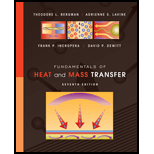
Determine F12 and F21 for the following configurations using the reciprocity theorem and other basic shape factor relations. Do not use tables or charts.
- Long duct

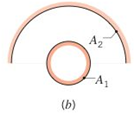



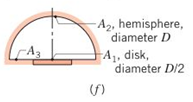
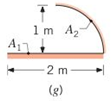

(a)
The shape factors.
Answer to Problem 13.1P
The shape factors are 1 and 0.212.
Explanation of Solution
Formula used:
The expression for the shape factor for surface 2 with respect to surface 1 is given as,
Here,
Calculation:
The geometrical shape is given as,
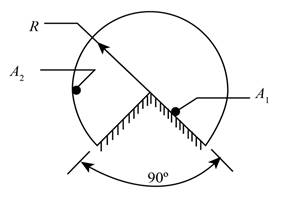
Figure (1)
The above geometry shows that inner surface completely intercepted by the outer surface. Therefore, the value of shape factors can be calculated as,
Conclusion:
Therefore, the shape factors are 1 and 0.212.
(b)
The shape factors.
Answer to Problem 13.1P
The shape factors are 0.5 and 0.25.
Explanation of Solution
Formula used:
The summation rule is given as,
The expression for the shape factor for surface 2 with respect to surface 1 is given as,
Calculation:
The geometrical shape is given as,
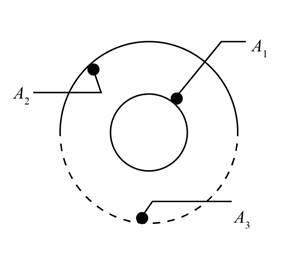
Figure (2)
The above geometry is a convex geometry, therefore the values of shape factor are obtained as,
Further obtaining the values of shape factor by summation rule as,
Further obtaining the values as,
The expression for the shape factor for surface 2 with respect to surface 1 is given as,
Conclusion:
Therefore, the shape factors are 0.5 and 0.25.
(c)
The shape factors.
Answer to Problem 13.1P
The shape factors are 1, 0.637 and 0.363.
Explanation of Solution
Formula used:
The summation rule is given as,
The expression for the shape factor for surface 2 with respect to surface 1 is given as,
The summation rule is given as,
Calculation:
The geometrical shape is given as,
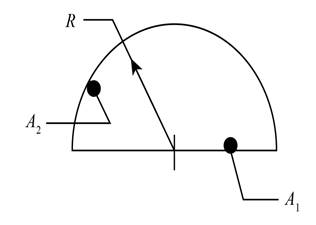
Figure (3)
The above geometry have a flat geometry at bottom, therefore the values of shape factor are obtained as,
Further obtaining the values of shape factor by summation rule as,
The expression for the shape factor for surface 2 with respect to surface 1 can be calculated as,
Further obtain the values of shape factor as,
Conclusion:
Therefore, the shape factors are 1, 0.637 and 0.363
(d)
The shape factors.
Answer to Problem 13.1P
The shape factors are 0.5 and 0.707.
Explanation of Solution
Formula used:
The summation rule is given as,
The expression for the shape factor for surface 2 with respect to surface 1 is given as,
Calculation:
The geometrical shape is given as,
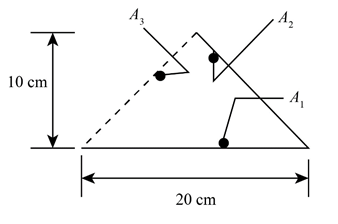
Figure (4)
The above geometry have a flat geometry at bottom, therefore the values of shape factor are obtained as,
Further obtaining the values of shape factor by summation rule as,
The expression for the shape factor for surface 2 with respect to surface 1 can be calculated as,
Conclusion:
Therefore, the shape factors are 0.5 and 0.707.
(e)
The shape factors.
Answer to Problem 13.1P
The shape factors are 0.5 and 0.
Explanation of Solution
Formula used:
The summation rule is given as,
The expression for the shape factor for surface 2 with respect to surface 1 is given as,
Calculation:
The geometrical shape is given as,
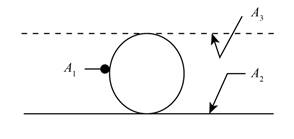
Figure (5)
The above geometry have a flat geometry at bottom, therefore the values of shape factor are obtained as,
Further obtaining the values of shape factor by summation rule as,
The expression for the shape factor for surface 2 with respect to surface 1 can be calculated as,
Conclusion:
Therefore, the shape factors are 0.5 and 0.
(f)
The shape factors.
Answer to Problem 13.1P
The shape factors are 1 and 0.125.
Explanation of Solution
Formula used:
The summation rule is given as,
The expression for the shape factor for surface 2 with respect to surface 1 is given as,
Calculation:
The geometrical shape is given as,
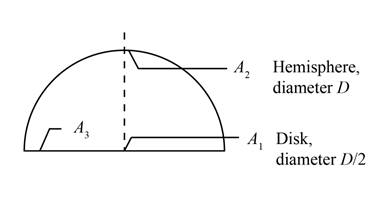
Figure (6)
The above geometry have flat disk surface, therefore the values of shape factor are obtained as,
Further obtaining the values of shape factor by summation rule as,
The expression for the shape factor for surface 2 with respect to surface 1 can be calculated as,
Conclusion:
Therefore, the shape factors are 1 and 0.25.
(g)
The shape factors.
Answer to Problem 13.1P
The shape factors are 0.5 and 0.637.
Explanation of Solution
Formula used:
The summation rule is given as,
The expression for the shape factor for surface 2 with respect to surface 1 is given as,
Calculation:
The geometrical shape is given as,

Figure (7)
The above geometry have flat disk surface, therefore the values of shape factor are obtained as,
Further obtaining the values of shape factor by summation rule as,
The expression for the shape factor for surface 2 with respect to surface 1 can be calculated as,
Conclusion:
Therefore, the shape factors are 0.5 and 0.637.
(h)
The shape factors.
Answer to Problem 13.1P
The shape factors are 1 and
Explanation of Solution
Formula used:
The summation rule is given as,
The expression for the shape factor for surface 2 with respect to surface 1 is given as,
Calculation:
The geometrical shape is given as,
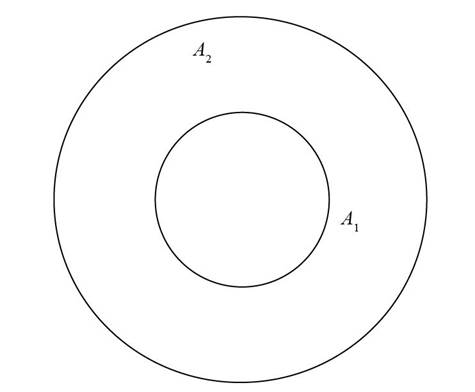
Figure (8)
The above geometry have spherical surface, therefore the values of shape factor are obtained as,
Further obtaining the values of shape factor by summation rule as,
The expression for the shape factor for surface 2 with respect to surface 1 can be calculated as,
Conclusion:
Therefore, the shape factors are 1 and
Want to see more full solutions like this?
Chapter 13 Solutions
Fundamentals of Heat and Mass Transfer
Additional Engineering Textbook Solutions
Fundamentals Of Thermodynamics
Fluid Mechanics Fundamentals And Applications
Heat and Mass Transfer: Fundamentals and Applications
Machine Elements in Mechanical Design (6th Edition) (What's New in Trades & Technology)
Thinking Like an Engineer: An Active Learning Approach (4th Edition)
- 1.28 The sun has a radius of and approximates a blackbody with a surface temperature of about 5800 K. Calculate the total rate of radiation from the sun and the emitted radiation flux per square meter of surface area.arrow_forward1.13 If the outer air temperature in Problem is –2°C, calculate the convection heat transfer coefficient between the outer surface of the window and the air, assuming radiation is negligible.arrow_forward11.31 A large slab of steel 0.1 m thick contains a 0.1 -m-di- ameter circular hole whose axis is normal to the surface. Considering the sides of the hole to be black, specify the rate of radiative heat loss from the hole. The plate is at 811 K, and the surroundings are at 300 K.arrow_forward
- A long wire 0.7 mm in diameter with an emissivity of 0.9 is placed in a large quiescent air space at 270 K. If the wire is at 800 K, calculate the net rate of heat loss. Discuss your assumptions.arrow_forwardThree thin sheets of polished aluminum are placed parallel to each other so that the distance between them is very small compared to the size of the sheets. If one of the outer sheets is at 280C and the other outer sheet is at 60C, calculate the temperature of the intermediate sheet and the net rate of heat flow by radiation. Convection can be ignored.arrow_forward1.11 Calculate the heat loss through a glass window 7-mm thick if the inner surface temperature is 20°C and the outer surface temperature is 17°C. Comment on the possible effect of radiation on your answer.arrow_forward
- Why does the shape of the passenger cabin windows on modern airplanes are rounded or elliptical? Why can’t it be a square or any shape that has edges? Explain and discuss your answer.arrow_forwardAn astronaut performing an extra-vehicular activity(space walk) shaded from the Sun is wearing a spacesuitthat can be approximated as perfectly white (e = 0) exceptfor a 5 cm × 8 cm patch in the form of the astronaut’snational flag. The patch has emissivity 0.300. The spacesuitunder the patch is 0.500 cm thick, with a thermalconductivity k = 0.0600 W/m °C , and its inner surface isat a temperature of 20.0 °C . What is the temperature of thepatch, and what is the rate of heat loss through it? Assumethe patch is so thin that its outer surface is at the sametemperature as the outer surface of the spacesuit under it.Also assume the temperature of outer space is 0 K. You willget an equation that is very hard to solve in closed form,so you can solve it numerically with a graphing calculator,with software, or even by trial and error with a calculator.arrow_forwardDetermine F12 and F21 for the following configurations using the reciprocity theorem and other basic shape factor relations. Do not use tables or charts.arrow_forward
- What is the solar radiation on a horizontal surface in the absence of the atmosphere at latitude 36° N on March 15 for one day?arrow_forwardTwo parallel concentric disks, 20 cm and 40 cm indiameter, are separated by a distance of 10 cm. The smallerdisk (« = 0.80) is at a temperature of 300°C. The larger disk(« = 0.60) is at a temperature of 800°C.(a) Calculate the radiation view factors.(b) Determine the rate of radiation heat exchange betweenthe two disks.(c) Suppose that the space between the two disks is completelysurrounded by a reflective surface. Estimatethe rate of radiation heat exchange between the twodisks.arrow_forward
 Principles of Heat Transfer (Activate Learning wi...Mechanical EngineeringISBN:9781305387102Author:Kreith, Frank; Manglik, Raj M.Publisher:Cengage Learning
Principles of Heat Transfer (Activate Learning wi...Mechanical EngineeringISBN:9781305387102Author:Kreith, Frank; Manglik, Raj M.Publisher:Cengage Learning
